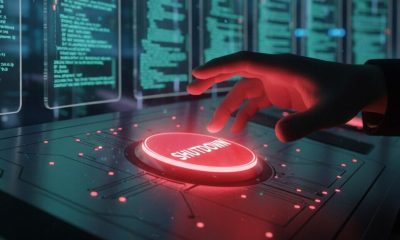

Metaverse
Stronger, scarier: A guide to AI in 2024 – Crypto News
While GenAI has captured everyone’s imagination and will continue to mature in the years ahead, the suit underlines the need for stronger global guard rails. Apart from copyright violations, there are fears of machines acquiring human biases and GenAI vapourizing millions of white-collar jobs.
Here’s a glimpse of how individuals and enterprises are embracing these technologies as of today and what we must expect this year.
Classical AI to Generative AI
View Full Image
By the time OpenAI’s large language model (LLM)-powered chatbot, ChatGPT, released on 30 November 2022, AI was already powering smartphones, digital wallets, search engines, online shopping recommendations, banking apps, healthcare products and services and weather forecasts, among other things. But ChatGPT heralded the rise of GenAI.
Other GenAI systems include Google’s Gemini 1.0, Meta’s LLaMA 2, Anthropic’s Claude 2, OpenAI’s Dall-E 2 and 3 and MidJourney.
Unlike traditional machine learning that can analyse data patterns to make predictions, GenAI systems can instantly create new articles, images, videos, presentations and even write simple code with the help of ‘prompts’ in natural languages like English and Hindi.
Large language models have more than 100 billion parameters. The second half of 2023 saw numerous small language models (SLMs) emerge. They have fewer parameters, consume less energy, are affordable and can perform domain-specific tasks relatively well after fine-tuning on fewer samples. Examples include LlaMA 2 13B (B stands for billion, and refers to parameters), Mistral 7B, Falcon-7B, IBM Granite-13B, and Microsoft Phi-2 2.7B.
So, where do we go from here?
Research firm Gartner believes that GenAI will impact the pharmaceutical, manufacturing, media, architecture, interior design, engineering, automotive, aerospace, defence, medical, electronics and energy sectors by augmenting core processes with AI models. It adds that 30% of outbound marketing messages from large organizations will be synthetically generated, up from less than 2% in 2022, even as more than 30% of new drugs and materials will be systematically discovered using GenAI techniques by 2025, up from zero today.
AI adoption is poised to add $500 billion to India’s GDP by 2025, according to Nasscom, an industry body.
That said, enterprises are treading this ground with a lot of caution since GenAI tools can be misused to create ‘deepfakes’ and generate fake copies of products. Further, since LLMs are trained on large amounts of publicly-available data, they can end up violating General Data Protection Regulation (GDPR) and intellectual property (IP). Enterprises also need to account for hallucinations (generating fake content) and privacy violations by such tools. Besides, GenAI models hog a lot of electricity, which could compromise an organization’s sustainability goals.
Ring-fencing AI

View Full Image
Some believe that the phenomenal growth of GenAI models indicates that machines will soon think and act like humans, a trend referred to as artificial general intelligence, or AGI. Some also call it artificial super intelligence, or ASI. Further, these models can plagiarize, be biased, and potentially replace thousands of routine jobs while also posing security and privacy risks. The fear is that if we are unable to fully understand the workings of these unsupervised networks, they could automatically evolve into Syknet-like machines we see in the Terminator movie franchise.
The cohort of people with this fear includes Elon Musk, co-founder of Tesla and SpaceX, and owner of X, formerly Twitter. It also has Masayoshi Son, CEO of SoftBank, and AI experts such as Geoffery Hinton and Yoshua Bengio. According to Son, ASI would be realized in 20 years and surpass human intelligence by a factor of 10,000.
The other cohort, which includes AI experts such as Yann LeCun, Fei-Fei Li, Andrew Ng, believe that AI is nowhere close to becoming sentient. They underscore that AI’s benefits—such as powering smartphones, driverless vehicles, low-cost satellites, chatbots, flood forecasts and warnings—far outweigh its perceived risks.
Despite their differences, all of them agree that AI and GenAI need to be reined in, and governments around the world are doing so. On 8 December, for instance, the European Union (EU) presented a comprehensive risk-based draft AI Act and is likely to publish the final text in early 2024. The Act seeks to ban biometric categorization systems that use certain sensitive characteristics, and untargeted scraping of facial images from the internet or CCTV footage to create facial recognition, among other things.
Earlier, the Group of Seven (G7), comprising Canada, France, Germany, Italy, Japan, the UK and the US, introduced guiding principles and a code of conduct for AI, even as all these countries have draft regulations in place. India is already a founding member of the Global Partnership on Artificial Intelligence (GPAI), an international forum that “aims to bridge the gap between theory and practice on AI by supporting cutting-edge research and applied activities on AI-related priorities”.
India, which has a Digital Personal Data Protection Bill, is soon expected to introduce the Digital India Act (DIA)—the new law is expected to regulate AI and intermediaries, even as the Indian government seeks to strike a fine balance between acknowledging the good in AI and penalizing its misuse.
The Indian LLMs

View Full Image
In December, Akash Ambani, chairman of India’s largest telecom service provider, Reliance Jio Infocomm, announced a partnership with the Indian Institute of Technology (IIT) Bombay to build ‘Bharat GPT’, an LLM tailored to suit the country’s needs. That very month, Ola co-founder Bhavish Aggarwal’s new company, Krutrim, too, joined the growing band of companies focusing on building India-specific LLMs. It is certainly the need of the hour but is easier said than done, given high computing costs and paucity of good Indian data sets.
The move makes sense since India is home to more than 400 languages, making it one of the most linguistically diverse countries in the world, and yet, most foundation models and LLMs are trained primarily using internet data, which is predominantly English. As per Statista, English was the most popular language for web content, representing nearly 59% of websites as of January this year. Russian ranked second with 5.3% of web content, followed by Spanish with 4.3%.
That said, many of the 22 official Indian languages do not have digital data, which makes it challenging to build and train an AI model with local data sets. Bhashini, a unit of the National Language Translation Mission, has so far spent $6-7 million to collect data from different sources, according to its CEO, Amitabh Nag. Bhashini has also employed more than 200 people to collect data (text as well as speech) and feed it into the system, following which the data is curated, annotated, and labelled.
Likewise, the ‘Nilekani Center at AI4Bharat’ at IIT Madras is building open-source language AI for Indian languages, including data sets, models, and applications. Sarvam AI, a generative AI startup founded by Vivek Raghavan and Pratyush Kumar (both co-founders of AI4Bharat), is developing LLMs specifically for India—the OpenHathi Series. Meanwhile, Bengaluru-based AI and Robotics Technology Park and the Indian Institute of Science are partnering with Google India to launch a LLM called Project Vaani.
CoRover, a GenAI company, has launched its own indigenous LLM called BharatGPT, which is available in more than 12 Indian languages in partnership with Bhashini. Last, but not the least, the Mahindra Group aims to construct an indigenous LLM, specifically designed to converse in a multitude of Indic languages. In the first phase, the Indus Project, as it is called, targets the inclusion of a remarkable 40 Hindi dialects.
Quantum is coming of age

View Full Image
The computers we use in our homes and offices today process information with bits (ones and zeroes), while quantum computers have qubits that can process the ones and zeroes simultaneously due to a property known as superposition. This means that two bits in your normal computer can be in four possible states (00, 01, 10, or 11) but can represent only one of these states at any given time.
A quantum computer, on the other hand, allows two qubits to represent the exact same four states at the same time, akin to four computers running simultaneously. Further, as you add more qubits, the power of your quantum computer grows exponentially. And a property called quantum entanglement allows qubits to communicate with each other even if they are miles (or even millions of miles) apart.
But building a quantum computer is very expensive and researchers have to address the unintended interactions between qubits and the environment, which are referred to as ‘noise’. Further, qubits are coherent—a property that keeps the qubits stable—only for a small amount of time. Adding qubits increases the decoherence, making the task even more challenging.
Nevertheless, companies including IBM, Google, Microsoft, Amazon, and Baidu, along with top research institutes, are racing to develop a ‘fault-tolerant’ quantum computer that can be used for real-world applications. And IBM is already working to integrate GenAI to help automate the development of quantum code for Qiskit, an open-source software development kit (SDK) for working with quantum computers.
Quantum computers can simulate molecular structures and interactions more accurately than classical computers, accelerating the discovery of new drugs, catalysts, and materials by predicting their properties and behaviour. For instance, scientists in China say their latest quantum computer, the JiuZhang 3, has solved a mathematical problem within a millionth of a second – more than 20 billion years quicker than the world’s fastest supercomputer could achieve the same task, according to a paper published by the peer-reviewed journal Physical Review Letters.
Further, quantum computers could also improve certain machine learning algorithms and optimization tasks by handling large data sets more efficiently or finding optimal solutions for complex models.
AI, the energy-guzzler

View Full Image
Flooding is estimated to impact more than 250 million people globally each year and cause around $10 billion in economic damages. AI and data analytics can help design better systems. As an example, Tamil Nadu, a state that gets flooded annually, has an integrated coastal flood warning system called CFLOWS, and a Real-Time Flood Forecasting and Spatial Decision Support System (RTFF & SDSS) for the Chennai basin. Even IIT-Madras has a high-resolution regional weather forecasting model, whose output is being integrated with the RTFF & SDSS on a pilot basis. Currently, though, the efficacy of the system is reportedly being hampered by lack of adequate field equipment.
That said, a good flood forecasting model can help researchers suggest better designs for stormwater drainage and flood management systems, among other flood interventions. Google Flood Hub’s AI, as an example, uses publicly-available data sources such as weather forecasts and satellite imagery. It’s being used in 80 countries, including India and Bangladesh. The system combines two models: the hydrologic model, which forecasts the amount of water flowing in a river, and the inundation model, which predicts what areas are going to be affected and how deep the water will be. Google is also working to expand flood forecasting alerts in Search and Maps.
Governments, meanwhile, could also use smart robots and drones for disaster management. AI-powered robotic flood control systems use autonomous robots that are equipped with advanced sensors and AI algorithms. It helps detect potential weak points in flood defenses—like cracks or erosions, and perform the necessary repairs.
While the use cases are promising, AI and generative AI are also energy-guzzlers. The most energy-and carbon-intensive tasks are those that generate new content: text generation, summarization, image captioning, and image generation. Tasks involving images are more energy-and carbon-intensive compared to those involving text alone. For instance, using a text-to-image model to craft an AI-generated image can require almost the same amount of power required to charge a smartphone, according to a paper released on arXiv by a team of researchers from Hugging Face and Carnegie Mellon University.
The researchers pointed out that global data centre electricity consumption has grown by 20-40% annually in recent years. However, the contribution of the AI sector specifically towards these figures is yet to be ascertained. As tech companies continue to build GenAI models, they will consume more energy, necessitating climate-friendly data centres and IT infrastructure, among other things.
-
Technology1 week ago
Blockchain for Good Alliance and UNDP AltFinLab Launch Blockchain Impact Forum – Crypto News
-
Technology1 week ago
Blockchain for Good Alliance and UNDP AltFinLab Launch Blockchain Impact Forum – Crypto News
-

 Blockchain1 week ago
Blockchain1 week agoTokenized Deposits for Payments, Treasury – Crypto News
-

 Metaverse1 week ago
Metaverse1 week agoTech layoffs: From Meta, Amazon to Google — these IT majors have cut AI related jobs – Crypto News
-

 Blockchain1 week ago
Blockchain1 week agoBitcoin Weekly RSI Points To More Upside, But Can the Bulls Defend $107,000? – Crypto News
-

 Technology1 week ago
Technology1 week agoThinking of cancelling HBO Max? Subscription prices just went up – Here’s what you need to know – Crypto News
-
Technology1 week ago
ProShares Files for Index Crypto ETF Tracking Bitcoin, Ethereum, XRP, and Solana – Crypto News
-
Business1 week ago
XRP Price Classical Pattern Points to a Rebound as XRPR ETF Hits $100M Milestone – Crypto News
-
Technology1 week ago
$1.68 Trillion T. Rowe Price Files for First Active Crypto ETF Holding BTC, ETH, SOL, and XRP – Crypto News
-

 Metaverse1 week ago
Metaverse1 week agoBezos fund believes AI can save the planet. Nvidia, Google are all-in. – Crypto News
-
Cryptocurrency1 week ago
Robinhood Lists HYPE As Hyperliquid Flips Aster, Lighter In Perp DEX Volume – Crypto News
-

 Cryptocurrency1 week ago
Cryptocurrency1 week agoCrypto update: Bitcoin and Ethereum are stable as market’s focus shifts to US inflation data – Crypto News
-

 De-fi1 week ago
De-fi1 week agoKDA Plummets as Kadena Organization Shuts Down Operations – Crypto News
-
others1 week ago
Japan Adjusted Merchandise Trade Balance down to ¥-314.3B in September from previous ¥-150.1B – Crypto News
-

 Blockchain1 week ago
Blockchain1 week agoHere’s Why The Shiba Inu Price Could Bottom And Rise Another 40% – Crypto News
-

 Technology1 week ago
Technology1 week agoChatGPT down: Thousands of users unable to access AI chatbot, OpenAI says it is working on a fix – Crypto News
-
Cryptocurrency1 week ago
XRP News: Ripple Unveils ‘Ripple Prime’ After Closing $1.25B Hidden Road Deal – Crypto News
-

 Cryptocurrency7 days ago
Cryptocurrency7 days agoTrump plans to pick Michael Selig to lead CFTC: Report – Crypto News
-

 Blockchain6 days ago
Blockchain6 days agoAfrica Countries Pass Crypto Laws to Attract Industry – Crypto News
-
Business6 days ago
White House Crypto Czar Backs Michael Selig as ‘Excellent Choice’ To Lead CFTC – Crypto News
-

 Blockchain6 days ago
Blockchain6 days agoBinance Stablecoin Outflow On A Steady Rise — What This Means For The Market – Crypto News
-
others5 days ago
JPY soft and underperforming G10 in quiet trade – Scotiabank – Crypto News
-

 De-fi5 days ago
De-fi5 days agoNearly Half of US Retail Crypto Holders Haven’t Earned Yield: MoreMarkets – Crypto News
-

 Cryptocurrency5 days ago
Cryptocurrency5 days agoUSDJPY Forecast: The Dollar’s Winning Streak Why New Highs Could Be At Hand – Crypto News
-
Business1 week ago
Crypto Czar David Sacks to Meet Senate Republicans In Bid To Advance Market Structure Bill – Crypto News
-

 De-fi1 week ago
De-fi1 week agoEthereum Foundation Announces Gas Limit Cap for Upcoming Fusaka Upgrade – Crypto News
-
others1 week ago
Veteran Trader Peter Brandt Says “MSTR Could Go Underwater” If Bitcoin Repeats 1977 Soybean Crash – Crypto News
-

 De-fi1 week ago
De-fi1 week agoCoinbase Acquires Echo for $375 Million to Expand On-Chain Fundraising – Crypto News
-

 Technology1 week ago
Technology1 week agoSundar Pichai hails ‘verifiable’ quantum computing breakthrough as Google’s Willow surpasses ability of supercomputers – Crypto News
-
others1 week ago
JPY weak and underperforming – Scotiabank – Crypto News
-
Business1 week ago
Breaking: Trump To Meet China’s President On October 30, Bitcoin Bounces – Crypto News
-

 Blockchain6 days ago
Blockchain6 days agoISM Data Hints Bitcoin Cycle Could Last Longer Than Usual – Crypto News
-

 Technology6 days ago
Technology6 days agoNothing OS 4.0 Beta introduces pre-installed apps to Phone (3a) series: Co-founder Akis Evangelidis explains the update – Crypto News
-

 De-fi5 days ago
De-fi5 days agoHYPE Jumps 10% as Robinhood Announces Spot Listing – Crypto News
-

 Blockchain5 days ago
Blockchain5 days agoEthereum Rebounds From Bull Market Support: Can It Conquer The ‘Golden Pocket’ Next? – Crypto News
-
others5 days ago
Platinum price recovers from setback – Commerzbank – Crypto News
-

 Blockchain5 days ago
Blockchain5 days agoXRP/BTC Retests 6-Year Breakout Trendline, Analyst Calls For Decoupling – Crypto News
-

 Technology5 days ago
Technology5 days agoSurvival instinct? New study says some leading AI models won’t let themselves be shut down – Crypto News
-

 Cryptocurrency5 days ago
Cryptocurrency5 days agoWestern Union eyes stablecoin rails in pursuit of a ‘super app’ vision – Crypto News
-

 Blockchain5 days ago
Blockchain5 days agoXRP Price Gains Traction — Buyers Pile In Ahead Of Key Technical Breakout – Crypto News
-

 Cryptocurrency1 week ago
Cryptocurrency1 week agoRolls Royce Stock: Is A Reversal In the Works? – Crypto News
-
others1 week ago
Pi Network Price Wedge Signals a Rebound as Key Upgrades Raise Utility Hopes – Crypto News
-
Business1 week ago
Is This Final Bitcoin Price Correction Before US Shutdown Ends, Fed Rate Cuts? – Crypto News
-

 Cryptocurrency1 week ago
Cryptocurrency1 week agoChainOpera AI soars 25% – But is COAI’s rally too good to last? – Crypto News
-

 Technology1 week ago
Technology1 week agoAI bubble isnt near a peak. Its only at ‘base camp’: Jen – Crypto News
-

 Cryptocurrency1 week ago
Cryptocurrency1 week agoCrypto slump worsens as Bitcoin slips amid a broad market sell-off – Crypto News
-

 others1 week ago
others1 week agoLikely to trade in a range between 0.6470 and 0.651 – UOB Group – Crypto News
-

 Blockchain1 week ago
Blockchain1 week agoBinance expands global crypto access with new USD transfer feature – Crypto News
-

 Blockchain1 week ago
Blockchain1 week agoKadena Shuts Down Operations – Team Confirms Immediate Cease Of All Activities – Crypto News
-
Business1 week ago
How the Crypto Market Could React to the Next Fed Meeting on October 29? – Crypto News












